Three years ago, Olympus announced the OM-D E-M1, the camera that would officially mark the end of its Four Thirds Digital ‘E System’ and become the brand’s first serious mirrorless product for professional photographers.
The E-M1 set a precedent by introducing exciting high-end features never before seen on a mirrorless body, such as on-chip phase detection autofocus, a large electronic viewfinder with high magnification, support for Four Thirds lenses, and complete weather resistance. Indeed, it could be called the model that kickstarted the mirrorless revolution.
A few days ago, we met the E-M1’s highly anticipated successor, the aptly named Olympus OM-D E-M1 Mark II. It takes everything good about the original E-M1 and amplifies it, all the while taking cues from its competitors. Let’s have a look at the ten main differences now!
Update: our complete comparison between the E-M1 and E-M1 II is now online. Check it out!
Ethics statement: The information supplied in this article is based on official specifications, press releases and our personal experience with Olympus cameras. If we get the chance to test the two cameras side-by-side, we will publish a full comparison. We were not asked to write anything about these cameras, nor were we provided any compensation of any kind. Within the article, there are affiliate links. If you decided to buy something after clicking the link, we will receive a small commission. To know more about our ethics, you can visit our full disclosure page. Thank you!
1. Design and ergonomics
Let’s start off with the design and ergonomics, which is actually one of the smaller differences. The handling of the original E-M1 was already wonderful, so it is likely that the designers went with the mantra “If it ain’t broke, don’t fix it!” when they conceived the E-M1 II. The dust, splash and freeze proof build is the same, as is the overall appearance of the camera. To say that they look like twins would be an exaggeration, but it is quite clear that they are part of the same family.
Of course, there are a few differences that need to be mentioned. First of all, the grip is larger and taller with a new indented shape to make the camera easier to hold with long lenses. Second, the position of the right-hand lug has been moved to a more comfortable spot on the top plate. And finally, the mode dial now includes the C1, C2 and C3 options found on the Pen F.
The E-M1 II is also slightly larger and heavier than the E-M1:
- 497g versus 574g
- 130.4 x 93.5 x 63.1mm versus 134.1 x 90.9 x 68.9mm.
Videomakers will be pleased to know that in addition to the mic input, the E-M1 II has a headphone output as well.
2. 16MP vs 20MP sensor and new processor
The second difference concerns the sensor. Although both cameras house a Micro Four Thirds type sensor, that of the new E-M1 II has a resolution of 20MP versus the 16MP of the E-M1’s sensor. The sensor was designed especially for the new flagship model and features enhanced pixel optics. Thanks to the new TruePic VIII double quad-core processing, dynamic range and low-light performance have been improved by 1 stop. The new sensor has a faster readout that improves rolling shutter (when using the electronic shutter) in comparison to the E-M1 sensor.
The E-M1 II also has Olympus’ High Res Shot mode that was introduced on the E-M5 II, added to the Pen F later on but never made it to the E-M1 due to the age and design of the hardware. Not only is it possible to take up to 50MP (JPG) and 80MP (RAW) shots, but the new TruePic VIII processor also reduces artefacts caused by moving elements, making this mode on the E-M1 II the most advanced so far. In our interview with Olympus, we were told that hand-held High Res Shot isn’t a possibility yet but is rather a final goal for the company.
3. Tilting vs Multi-Angle LCD screen
The original E-M1 featured a touch sensitive monitor that tilted up 90 degrees and down 45 degrees, and was perfect for still shooting at awkward angles.
Since the new E-M1 II is also a very capable video camera as we’ll discover later on, Olympus opted to implement a multi-angle touch sensitive monitor similar to those found on the Panasonic G and GH series.
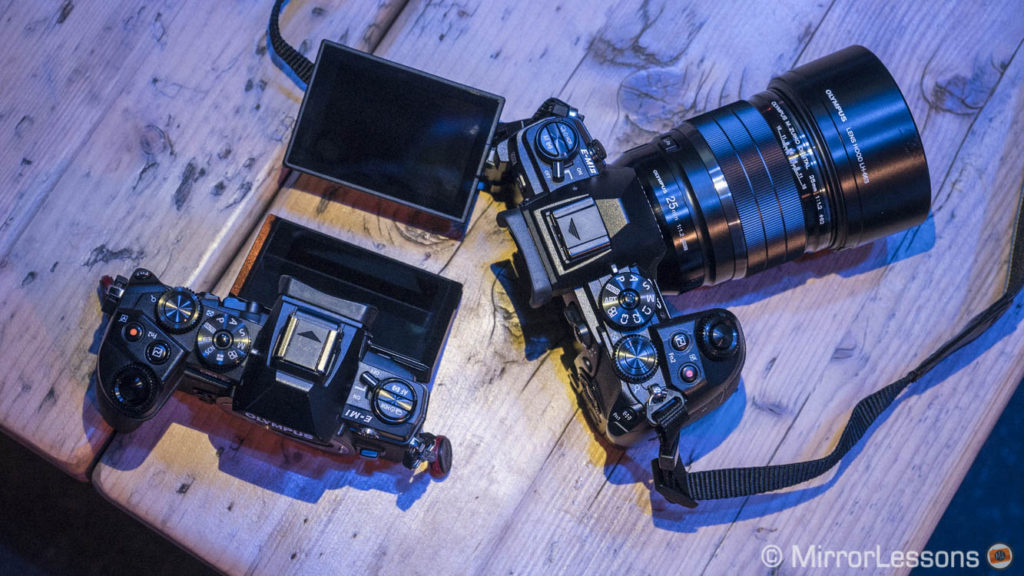
Both LCD monitors are a 3-inch type with a resolution of 1037K dots and 7 levels of brightness adjustment. Colour balance is available in 7 levels on the E-M1 II and 3 levels on the original E-M1.
4. New responsive EVF
When the E-M1 was announced three years ago, it had the best electronic viewfinder on the market. In addition to an impressively large 1.48x magnification, it also benefitted from 2360K dots of resolution, a high resolution refresh rate of 60fps (or 120fps at a lower resolution), 100% field coverage, a fast response rate of 0.16 milliseconds, and, via firmware, S-OVF to expand the Live View dynamic range. It didn’t take long for other manufacturers such as Fujifilm and Sony to catch up but the E-M1 will always be remembered as the camera whose EVF set the bar nice and high.
The new E-M1 II has an updated EVF: the resolution and magnification are the same but it features a new panel, a response rate of barely 6 milliseconds and a smooth high resolution frame rate of 120fps available in full resolution to help you follow moving subjects better.
5. Full HD vs 4K video
A monumental addition to the E-M1 II is 4K video, putting it on the same playing field as other mirrorless flagship cameras such as the Fujifilm X-T2, Sony A7r II and Panasonic GH5.
Specifically, it is capable of shooting in 4K at 30fps with 102Mbps bit rates without any sensor crop. (It is still uncertain whether this is with full pixel readout.) Also included is a 24p frame rate option and 237Mbps in Cinema 4K format. The camera’s 5-axis sensor stabilisation works for video: there is an 8% crop when using the electronic stabilisation but no crop with the mechanical stabilisation.
The new OM-D can also shoot Full HD up to 60fps and you have the option of conforming the file to 24 or 25fps to have slow motion in the final result.
The E-M1 wasn’t designed for video shooting and its specifications reflect that. It is capable of Full HD up to 30fps with a 24p option, and you get 5 axis stabilisation for video (with firmware 4.0) and 28Mbps.
6. Revamped autofocus system
At the Olympus press event, the feature that was touted above all others was the new autofocus system of the E-M1 II and the resulting speed for stills and video.
The camera features a brand new on-chip phase detection AF system with:
- 121 all cross-type AF points (75% vertical and 80% horizontal sensor coverage)
- a faster high-speed algorithm powered by the TruePic VIII processor
- a dedicated subject-moving algorithm to deliver reliable focus when tracking moving subjects
The sequential shooting speed in full resolution RAW is much improved, capable of up to 10fps with the mechanical shutter and 18fps with the electronic shutter in continuous autofocus. With AF and AE locked, this speed goes up 15fps with the mechanical shutter and 60fps with electronic shutter.
If you were wondering whether rolling shutter is present at 18fps / 60fps, Olympus states that it should no longer be an issue unless you are photographing extremely fast subjects such as a spinning fan or the propeller of an airplane. For slower subjects such as moving animals or people, it should work well.
Also new is the Pro Capture mode which takes up to 14 RAW frames before the shutter button is fully pressed. You can stop the camera from taking more than a specified number of images in a burst after the shutter button is fully pressed.
The E-M1 II also has new AF settings included AF Scanner (controls the back and forth movements of the lens elements) and AF Limiter (limits the focus distance to a certain range as you can do with many telephoto lenses). There is a new 5-area group for the AF points in addition to the All, Single and 9 area you can also find on the E-M1.
The original E-M1 had a maximum sequential shooting speed of 10 fps in S-AF / 9 fps in C-AF (with firmware 4.0). Its hybrid autofocus system includes 81 AF points that enables the use of 4/3 lenses as well.
7. Improved 5-axis sensor stabilisation
The 5-axis sensor stabilisation of the E-M1 was and still is one of the key selling points of the series because it works with any lens, regardless of brand or age. With the E-M1 in the past, we managed to take sharp shots down to shutter speeds as slow as 1 second when using a wide-angle lens such as the M.Zuiko 12mm f/2. Sure, it takes a few tries, but it is possible if you are steady. The official compensation by CIPA standards is 4 Ev steps and 5 Ev with compatible Sync IS lenses.
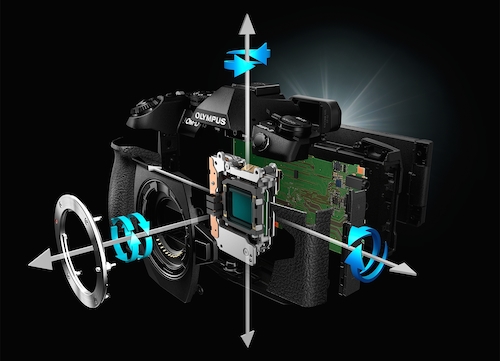
On the new E-M1 II, the 5-axis sensor stabilisation has been re-designed, compensating up to the equivalent of 5.5 steps on its own and 6.5 steps at 100mm when combined with a lens that uses Olympus Sync IS system such as the 12-100mm f/4.0 IS PRO.
What’s more, it works for 4K video, so you can easily take stable video footage without a tripod (though it has yet to be seen just how effective the camera is at controlling distortion and the so-called “jello” effect). To see what the potential is, watch the video below recorded with the E-M1 and 300mm PRO and imagine that the E-M1 II could theoretically perform even better!
8. New menu system
Since the beginning of the OM-D series, users have been asking for a more straightforward menu system. With the E-M1 II, the design of the menu has changed and new options have been added. However, the organisation of the menu options hasn’t been radically changed. The video settings are now accessible from the main left column and a few other settings have been moved.
9. New long-lasting battery
An update that we’ve all been hoping for is improved battery life, and now our prayers have hopefully been answered.
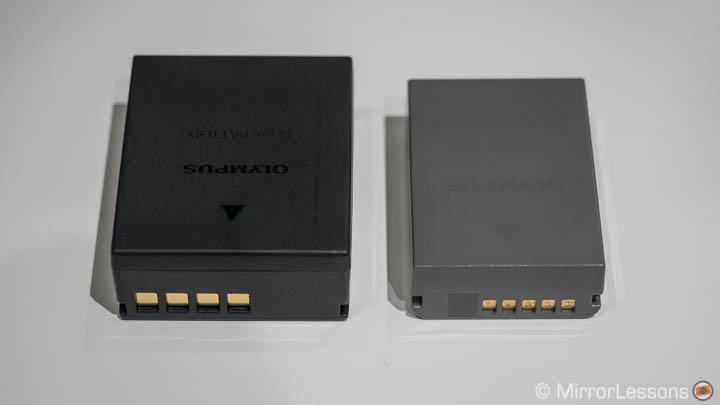
According to Olympus, the capacity of the new BLH-1 battery has been increased by 40% compared to the E-M1’s BLN-1 battery and the power consumption is similar on both cameras.
The BLH-1 is quite a bit larger than the BCH-1, and also more intelligent, storing information about battery health and the number of shots you can take. Usefully, it stores this information even if you swap the battery between two or more E-M1 II cameras. What’s more, the battery charge now displays on the LCD as a percentage and a separate status menu is available to check on the overall battery condition.
The new battery charger also has a few tricks up its sleeve: depending on the blinking sequence, you can tell whether the battery has been charged 1-40%, 40-80% or 80-100%, and the charging time takes only two hours with the BCH-1 charger, which is half the time it takes for the BLN-1 to charge.
Sadly, Olympus confirmed that the camera cannot be charged via USB.
10. Dual SD card slot
A welcome addition for professional photographers is a Dual SD card slot on the E-M1 II. Slot number 1 can take UHS-II cards while the second is only compatible with UHS-I cards. You can use the second slot as a back-up to save JPGs while saving RAW files to the first slot, or switch to the second slot when the card in the first slot is full.
On the E-M1, only one slot is present (UHS-I compatible).
Conclusion
If you are a current OM-D E-M1 user and love the Micro Four Thirds system, the OM-D E-M1 II may just be the upgrade you’ve been so patiently waiting for.
The new flagship takes everything good about the original E-M1 and makes it better, from the design and the autofocus system to the 4K video capabilities and small details such as the additional sensor resolution, extended battery life, and upgraded sensor stabilisation.
Does the arrival of the E-M1 II suddenly mean that the original E-M1 has become inadequate for professional work? Absolutely not. As we were saying to one of the product managers the other day, it is amazing just how relevant the E-M1 still is despite its “old age” in digital technology terms.
Whether you choose to stick with the E-M1 or upgrade to the new flagship ultimately depends on your end goal. Do you shoot lots of wildlife and action? Would you really benefit from 4K? If you answered “yes” to either of these questions, we bet that your mind has already been made up!
Check price of the Olympus OM-D E-M1 II on
Amazon | Amazon UK | eBay | B&H Photo
Check the price of the Olympus OM-D E-M1 on
Curious to know more? Then check out our complete comparison between the E-M1 and E-M1 II!

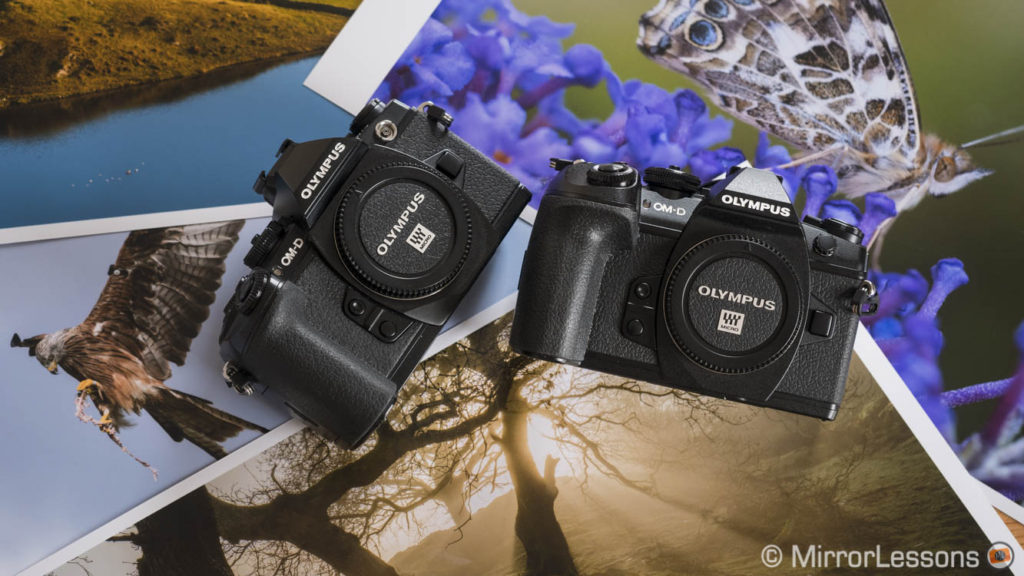



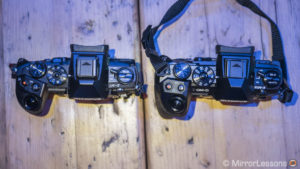

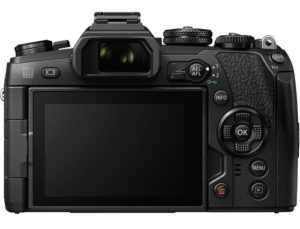


Nice summary of the changes, thank you. The captions under 4) are reversed though.
Oops, good catch!
lets just hope they do not change the price to much
We were told that it will be a little more expensive than the E-M1’s original retail price. 🙂
$2000
Very much looking forward to your video review
Same here.
The movement of the AEL/AFL button is a very nice and needed touch too, as the position on the MkI is too far for comfortably reach it w/ your thumb. Now it supposedly will work as intended, and along w/ the nearby touchscreen for AF frame selection, I believe AF will be a smooth, quick and intuitive action :).
My first reason to change from dlsr TO Mft was weight… and now topmodells are Heavier than my dslr s before….
Too expensive for Noisy Sensor Camera Expensive, Olympus want to get back from the corruption scandal